176 Search Results for prompt
February 2, 2015
by Carole Zangari -
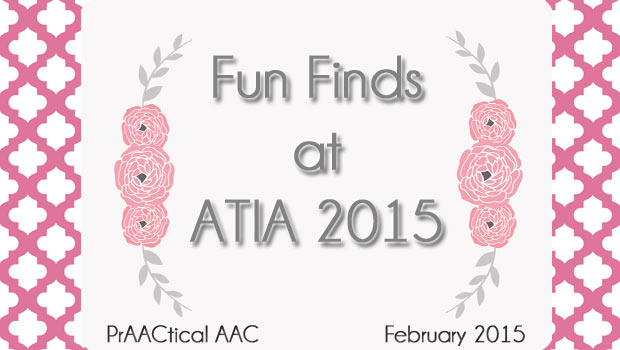
The ATIA 2015 Conference was one of the best ever, with strong presentations, a vibrant exhibit area, lots of fun social events, and great networking opportunities. There were lots of highlights, but here are a few prAACtical ‘finds’ that might interest you. Spanish version of Word Power: The language options for AAC devices and apps keeps getting better and better! I love that you can purchase the Spanish pageset/voices, then configure Word Power so that the user can toggle back and forth between English and Spanish user profiles. Once configured, your client can independently go from English to Spanish words, phrases, grammar, and voices (and vice versa). This will help our prAACtical friends who speak English in school and Spanish at home. I explored it on the Nova Chat from Saltillo but there is also a Spanish add-on to the TouchChat app. Book Bridge: We’re all looking for better ways to make... [Read More...]
January 29, 2015
by Carole Zangari -
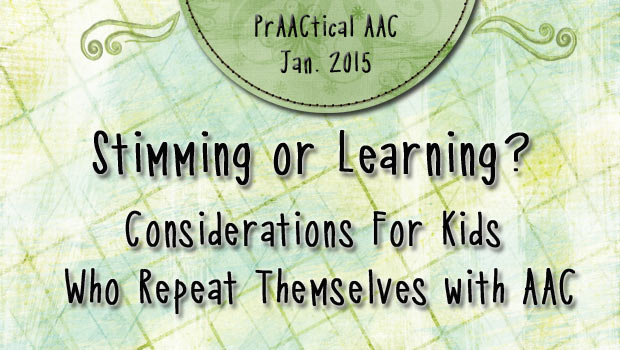
At the CARD 2015 conference earlier this month, I had some great conversations with professionals who wanted to integrate more AAC into their work with beginning communicators. One of the issues that came up was this: What about kids who keep using their AAC to say the same thing over and over? Here are some of the things we discussed. For beginning communicators, repetition is part of exploration. And exploration is part of language learning. Extinguish repetition and we have effectively shut down a tool for language development. Turning off the device, taking it away, or turning the volume controls to silent is NOT an option. (Whew! I can’t tell you how happy I was to hear consensus on that point!) No feeling person would tape the mouth of a speaking child to keep them quiet, and this is the AAC counterpart. Silencing a person by restricting access to their... [Read More...]
December 23, 2014
by Carole Zangari -
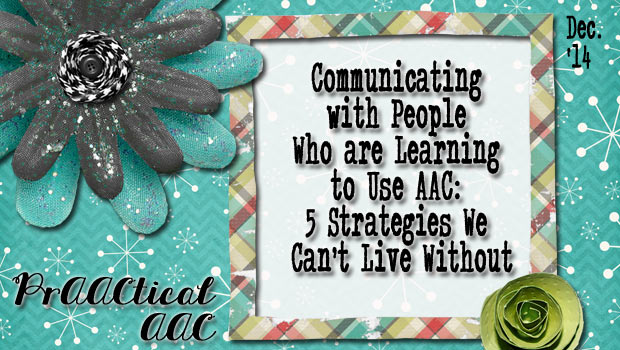
Don’t pre-empt: Give them a chance to express themselves by not automatically anticipating and meeting every need they have. What can make us nurturing caregivers sometimes gets in the way of building new communication skills. Create opportunities: Engineer those ‘teachable moments’ by using communication temptations. Making them want to communicate is half the battle. Slow down and pause: Nature abhors a vacuum. And we SLPs have a terrible time NOT talking. That’s a shame, really, because those ‘perfect pauses’ are wonderful teaching tools. Speak AAC: We can’t say this often enough. To teach someone to communicate with AAC symbols, we must speak to the learners using those same tools. When we want someone to use their communication aid more often, we make it a priority for US to use the AAC more frequently. That’s just how it works for beginning communicators. Prompt wisely: A little prompting is a good and... [Read More...]
December 11, 2014
by Carole Zangari -

Today we welcome back SLP Shareka Bentham to share her prAACtical adventures in the kitchen. You can see her previous posts here. For the past few months I have been having lots of fun using functional ways to teach my little ones vocabulary for items around the house. “Around the kitchen” is a favourite theme, since we always get to explore the kitchen, and make some yummy treats. I’ve found in my sessions that many children can recognize many of the items in the kitchen, and are aware of their function, but don’t actually know the names of these objects. It has been my goal then for children to be able to label at least 15 items within the kitchen. Vocab items range from the fridge, stove, blender, to food items, spoons, dish towel. Through these activities we have also highlighted the need to be able to talk about many... [Read More...]
November 25, 2014
by Carole Zangari -
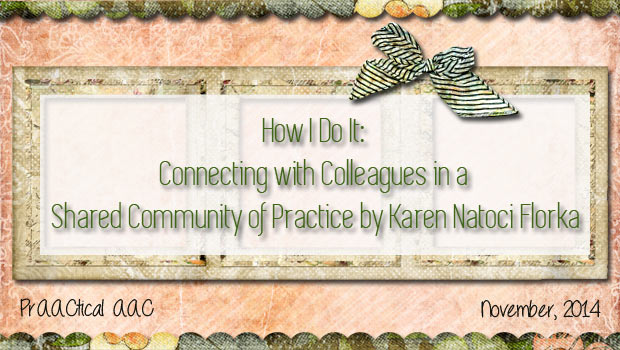
I had the pleasure of meeting Karen Natoci Florka last month when I visited Michigan and am delighted that she was willing to introduce us to the Shared Community of Practice from the team at The Communication Matrix. Karen is an SLP who has served students aged 3-26 with various physical, sensory and intellectual challenges at Wing Lake Developmental Center (Detroit area) since 2001. She is a part time lecturer at Wayne State University where she teaches a course entitled “Communication Acquisition and Educational Interventions for Students with Moderate to Severe Impairments.” She is part of the Communication Matrix Charter group. Click on the image below to learn more. The Communication Matrix is growing into a Shared Community of Practice! I remember the first few weeks in my new job at a wonderful, magical, school for children with complex communication needs. It was time for my first evaluation. These amazing students were challenging! They seemed... [Read More...]
November 10, 2014
by Carole Zangari -
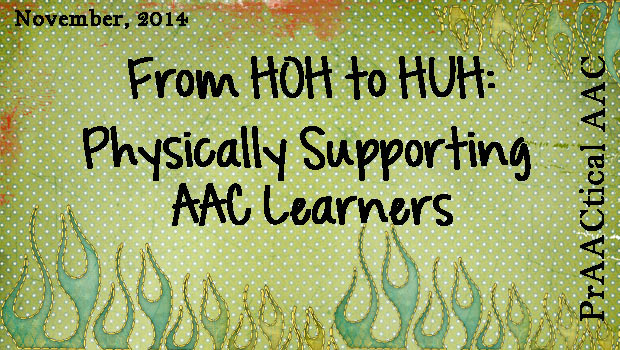
We’ve talked a lot about prompting strategies in previous posts, but today we look at one specific type: Physical assistance. Whether it is pointing to a symbol, activating the message window, turning pages in a communication book, or other early skills, beginning users of AAC often need a good deal of physical support to exhibit the desired behavior. Our first inclination may be to help the learner by using hand-over-hand (HOH) prompting, which is certainly effective in guiding them through the behavior. An even better way to support them, though, is hand-under-hand (HUH) prompting. With HUH, we guide learners by placing our hands under their hand (or just next to their hand) as we complete the desired behavior. HUH is frequently used with learners who have vision impairments and those who are deafblind. We find that it has much broader utility and can be a superior way of supporting some students... [Read More...]
November 6, 2014
by Carole Zangari -
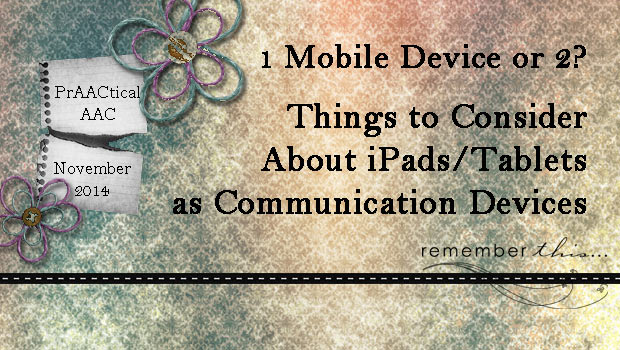
Should iPads and tablets be used both for communication and other things? That’s a question we hear rather frequently these days. Our answer will probably frustrate you. Ready? Here goes: It depends. It depends on the learner. Consider these two students. Tia is 6 and very much a beginning communicator. She has had her mobile device with a core language based AAC app for a few months. Tia uses it independently to ask for a few of her favorite things, like music and bubbles. With prompting she can use it to ask for a wider variety things, and can also use it for commenting, labeling, greeting, and answering ‘what’ questions. She does not yet combine two symbols to make short sentences. Yvette is 15 and has been using AAC since she was a toddler. She uses a text-to-speech app on her mobile device and knows how to program phrases and... [Read More...]
October 16, 2014
by Carole Zangari -
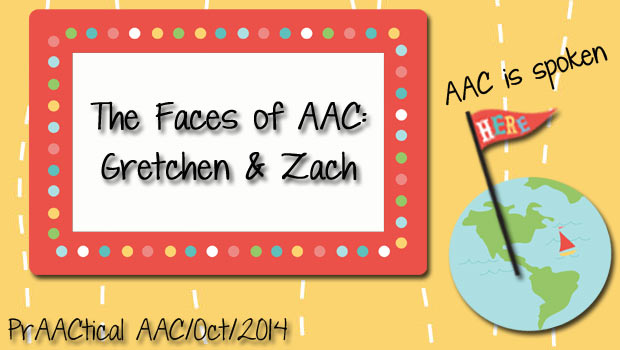
From Bielsko, Poland, to Denver, USA, we are continuing to share the Faces of AAC. Today, we meet SLP Gretchen Storm, who works in the public school system and has a private practice. Gretchen enjoys collaborating with parents, children, teachers, other healthcare providers, siblings and peers in strategies and facilitating communication through speech generating devices. In this post, Gretchen introduces us to Zach. :::::::::::::::::::::::::::::::::::::::::::::::::::::::::: Zach is an 11 year old who uses a Tobii I-12 eye gaze communication device to communicate. He previously used a switch scanning method on a VMax from Dynavox. Zach recently switched to an eye gaze device. Though he loves to use his arms and hands whenever possible, his motor control of them is not ideal for the consistent switch access needed for switch scanning. He was switched to an eye gaze system which could also serve as a switch scanning device if in the future he demonstrates improved... [Read More...]
September 22, 2014
by Carole Zangari -
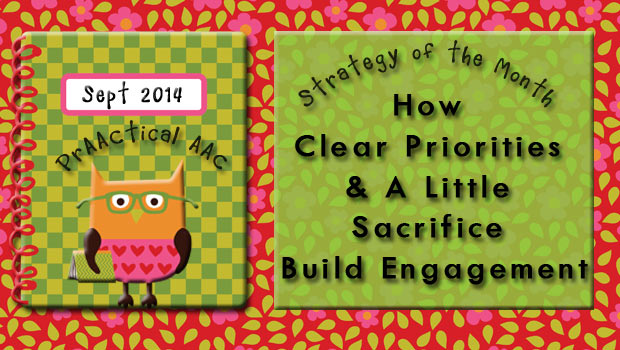
We can’t complete our thoughts on engaging AAC learners without a bit of conversation around the topic of priorities. Here’s the main idea: Go into each activity having a clear priority for what you want to achieve. Everything else become negotiable. As SLPs, sometimes we want it all. We want therapy activities where the AAC learner initiates communications, uses new vocabulary, creates novel sentences, experiments with new grammatical forms, and kicks some morphological butt. We.want.it.all. After a few decades of being an AAC practitioner, I think I’m finally learning that trying to have it all isn’t always the best option. It isn’t about what I want, it’s about what my client needs. Sigh. In this approach, we look at the lesson or activity and create our “Must Have List.’ For Mayra, a kindergartner just learning to use symbols for the first time, our lessons ‘must’ be engaging, have high pay-off... [Read More...]
September 15, 2014
by Carole Zangari -
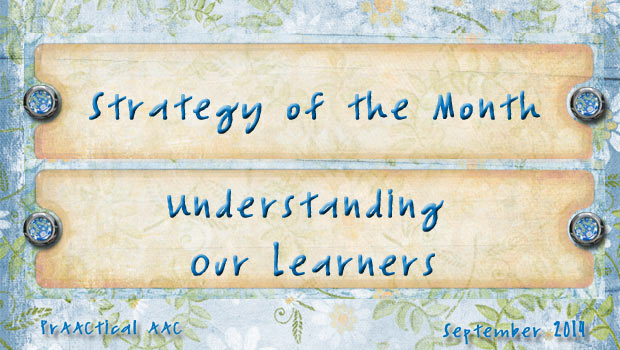
This month, we’re thinking about what it takes to create therapy sessions that engage our AAC learners. A big piece of that is challenging learners at an appropriate level. It’s a simple concept, but can be tricky to translate for an individual learner and task. As much as we try to, it’s hard to really get a feel for what our clients are experiencing. Our bodies work well, for the most part, so we don’t automatically account for differences in sensory processing, motor control, executive functioning, cognition, or memory. We try. We really do. But I’m not sure we do it as well as we hope to do. Revisiting these concepts as an intellectual exercise isn’t going to fix that, but for me (and maybe some of you), it can serve as a helpful reminder. Awareness Ours is an empathetic profession. Still, we don’t always truly understand what our clients... [Read More...]









